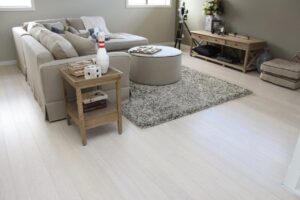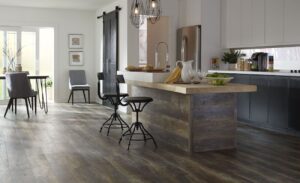Have you ever imagine to pick up linoleum for basement floors?
Will it be durable and resistant to the moisture as the major issue of wet environment?
Linoleum is basically the original of resilient flooring.
In 1950s, this flooring was widely used for the high traffic flooring areas in wet locations where moisture is strongly unavoidable until vinyl flooring product replaced the existence of linoleum and be the favorite building material.
Frequently, people make mistake by mentioning vinyl as linoleum though the both products are extremely different.
In this case, linoleum is mainly constructed from linseed oil along with the other natural plant materials that are formed into sheets.
On the other hand, vinyl flooring is totally synthetic and made of refined materials.
In these times of ours, linoleum comes back to the world of flooring due to the consumers’ demand about the natural and green materials.
Linoleum comes with the renewable materials, meaning that it does not product any pollution like vinyl flooring does.
Linoleum can break down when it is discarded in the landfill.
In the world of flooring, linoleum is a perfect choice for flooring especially for below-grade basement locations. It is not only purely natural but also highly resistant to moisture and humidity.
Nevertheless, let’s be aware of the flood that may ruin the floors during the installation.
This is because the locations are prone to dampness that may lead to a problem because of the weak adhesive bonding.
To get a deeper understanding about the use of linoleum for high-moisture locations, let’s have a quick read on linoleum for basement floors we are just going to share including the linoleum products, below-grade flooring concerns, humidity in basement, comparative costs, installation overview and the reasons why linoleum is much recommendable for basement.
Linoleum Products
Most manufacturers produce linoleum in small, discrete tiles and long rolls of sheet materials.
This way, it is quite possible to stretch them across the basement floors.
The tiles may be pretty easy to install but the seams between the tiles are the downside since they are prone to moisture penetration and staining agents.
On the contrary, sheet linoleum will be strongly solid and unbroken, making it resistant to water either from above or below.
Marmoleum company with the other flooring manufacturers recently develop a rigid click-together plank completed by a linoleum wear layer which is laminated to the plank top part.
Similar to the plastic laminate flooring products, Marmoleum floors is designed to float over an underlayment sheet.
Though these floors are highly marked for certain applications, they are not listed as the good options for basement and other wet areas because there are too many seams between the planks.
Read Also: Lamett Laminate Flooring Review
Below-Grade Flooring Concerns
In linoleum for basement floors ideas, the threat of occasional flooding is the most challenging thing to face by the basement floors.
Flooding occurs when the water table in your room rises above the basement level. It causes the water seep up and in through the walls and cement slab subfloor.
Plumbed applications such as washers and water heaters as well as water lines are also seeping up and in the floors.
If there is any malfunction in one of those applications, flood can surely occur.
The surface of linoleum is already resistant to moisture penetration though a flood may still seep down into the seams along the walls and even between the tiles.
These cause the materials to curl warp and make the adhesive weakening.
Other below-grade issue we must also concern is the mold that can stay beneath the floor and in the concrete of the subfloor.
In this case, a flood may not affect the materials but it can ruin the installation.
Humidity in Basements
Humidity is the second best source of flooring issue after the moisture.
Due to the fat that basement is below ground level, the humidity may drastically change over the seasons and even over the days.
Referring that the air characteristic is moist, the adhesive used in linoleum can begin to weak.
Thus, to make a floor that loosens in many parts, you can mix the use of curling tiles and sheet edges.
If there is a humidity issue in your basement, you can continue using the linoleum flooring since the individual tiles can be replaced and the adhesive can also be reapplied.
In the other words, though you may face a problem in using the linoleum flooring, you don’t have to worry since you can replace the individual tiles as well as reapply the adhesive.
Hence, it is much recommended that you use the dehumidifier in the basement to keep the linoleum floors unbroken.
Comparative Costs
Considering linoleum for basement floors may also require you to know the comparative costs of the flooring.
In this case, linoleum flooring is not usually available in the big box home improvement centers where the vinyl flooring mostly dominates.
At some specialty flooring stores, linoleum usually comes with the price $2 to $4 per square foot.
This cost is already comparable to the vinyl flooring costs. If you want a less expensive linoleum, you can opt the sheet form rather than the tiles.
In this case, linoleum is considerably more affordable than the ceramic tiles which are usually costs $5 to $10 per square foot.
However, ceramic tiles have a longer lifespan than the linoleum floors that is about 10 to 20 years to come.
In short, you may expect the most affordable price of a flooring product but you cannot expect the long lifespan of it. What you pay, what you get.
Installation Overview
Fortunately, it is not too difficult to install linoleum flooring. There is no special preparation steps needed for the installation.
One thing to remember is the fact that you cannot install the linoleum on the concrete subfloor slab in a basement due to porous material of the concrete.
Moreover, the subfloor slab is also in direct contact with the soil around the house.
By times, the moisture is seeping from the soil around the concrete and make the adhesive difficult to set on the linoleum surface.
If you just insist on installing linoleum in the basement, start by firstly installing the plywood subfloor over the concrete.
Use and place the water barrier between the plywood and the concrete. This is aimed to prevent the water from warping and damaging the floor.
Typically, the masonry nails are used to make the plywood anchored to the concrete. Later, the linoleum tile or sheet is laid over it.
Linoleum In A Finished Basement
The next thing to review in linoleum for basement floors is linoleum in a finished basement. Finished basement is usually a room extension of a home.
It is usually designed to change the natural and dark area to a room that everyone can enjoy with all of the families or friends. Finished basement is typically dry.
However, it is much recommended that you not make the room taken to direct water and stay away from the moisture.
Hence, finished basement will not matter what flooring type you are going to choose to install.
For this kind of location, ceramic tile may feel too cold and hard but carpeting can be prone to mold and mildew.
Keep in mind that even the most carefully maintained finished basement, humid can still be a problem to consider.
In this regards, linoleum flooring is best considered a good option for finished basement due to the durability and great resistance to moisture. Linoleum is soft and comfortable for any living areas.
Why Linoleum Is Much Recommended For Basement
In fact, as a resilient flooring material, linoleum comes with the strong characteristics to convince you that it is the best flooring option you can consider for basement.
Those are:
Durability
As we have mentioned in the previous section, linoleum is a resilient flooring with a high durability.
This is because linoleum is designed with the characteristics of resistance to moisture, scratches, dents and mars on the surface of the flooring materials.
In most cases, the damages are caused by the new manufacturing processes and curling.
These can actually be prevented by performing the proper installation and regular sealing maintenance.
This means that you had better hire a professional installer to do the project. And, you need to seal the floors every few periods to keep the floors in a good condition.
Anti-Static
In fact, most of the flooring materials are collecting dust, dirt and other small particles. They hold them tightly and radiate them back into the air. This can cause an allergic reactions in some people with respiratory sensitivity.
In this regards, linoleum flooring contains anti-static property that is aimed to repel the dangerous particles from the flooring surface.
Colorfast
Many people love linoleum. Well, it is probably due to the hues and patterns that extend down through the wear layer.
Thus, you won’t see any part of the flooring that fades and mars in the flooring surface over time.
Anti-Microbial
Linoleum for basement floors contains anti-microbial properties that naturally inhabit the growth of microscopic organism and germs. This makes linoleum flooring popular for hospitals and schools.
Moisture
In the world of flooring, moisture is the major problem causing stress to flooring.
Like any other flooring types, linoleum can easily get damaged by the existence of moisture in the basement and other wet locations such as kitchens, bathrooms and laundry rooms. Thus, installing linoleum in basement need a proper sealing.
Noticeably, if you are performing a proper installation, linoleum flooring will fit much for not only basement but also kitchens and bathrooms in your house.
Comfort
Is it comfortable enough to walk on linoleum in basement?
Why not?
Linoleum is typically soft and comfy underfoot. It makes you feel warm even the temperature is so cold in the winter.
Simple Installation
Truly, installing linoleum in basement is not only simple but also relatively easy. This way, you don’t have to use any grout.
Simply, you can install linoleum flooring as floating floors that need no adhesive at all. Further, the linoleum tile and plank are also easier to install than the sheet linoleum.
Style
Choosing linoleum flooring can be due to the style options availability, too.
In Victorian era, this flooring is very popular. It was well-combined with the antiques and other classic style furnishing more than the vinyl and rubber flooring.
In short, not only the basement compatibility will be the reason why people choose the linoleum floors but also the style.
Read Also: What Should You Know about the Facts and General Laminate Flooring Cost
Upgrades
The linoleum manufacturers keep innovating to produce the planks and tiles with the feature of hard surfaces and thicker body.
This is aimed to increase the positive advantages of this linoleum flooring materials.
Green Factors
Truly, most homeowners tend to choose linoleum for basement floors due to the green factors presented by the flooring.
Basically, linoleum flooring products are mainly constructed from the natural material that is the linseed oil along with the other natural materials such as cork powder and other organic additives.
So thanks to the natural linseed oil that form the linoleum sheet, tile and plank floorings.
Besides, linoleum is also easily renewable so that it is safe for the environment when they are discarding the floors and let them stay in the landfill.
In this case, linoleum flooring can easily break down without polluting the landfills.
Though some linoleum installation uses adhesive, however, the major linoleum types chosen by the homeowners are the floating floors.
Note, linoleum floating floors do not require the use of adhesive, thus, they do not come with any toxic chemicals of adhesive in your home.
Environment and the level of traffic in the basement will determine much how long the linoleum flooring will last.
Yet, typically, the general linoleum floors can last for 20 to 40 years or even longer.
In the end of the flooring life cycle, linoleum flooring can be burned in order to produce the clean energy source. It can also be laid into a landfill.
Due to the fact that linoleum is biodegradable, leaving no harmful off-gassing.





